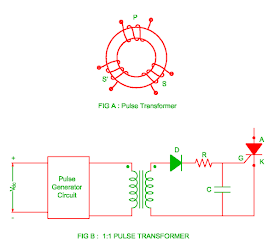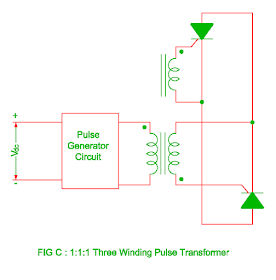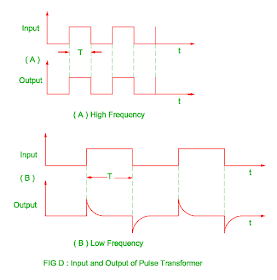In this post, function, structure, effect of frequency on output
pulse, advantages and disadvantages of pulse transformer is discussed.
Pulse Transformer
Function of Pulse Transformer
- The function of pulse transformer is to generate pulse for semi conductor device and provide electrical isolation.
Construction of Pulse Transformer
- The figure A shows toroidal shaped pulse transformer.
- It consists of one primary winding and one secondary winding.
- Each winding consists of same number of turns therefore any winding works as primary or secondary winding.
- The pulse to SCR is given by 1:1 or 1:1:1 pulse transformer.
- The pulse to the back to back SCR is given by the three winding pulse transformer.
- The firing circuit of gate pulse by 1:1 pulse transformer is given in the figure B.
- The function of the series resistor R is to limit the holding current of the SCR.
- The function of diode D is to prevent reversing gate current. The 1:1:1 pulse transformer is used to generate pulse for back to back SCR.
Design Consideration of Pulse Transformer
The
design of Pulse transformer is made such that
- Its efficiency should be high.
- The inductance of primary winding should be high in order to reduce magnetizing current.
- The direct current flows through primary winding of pulse transformer in order to prevent saturation of the core.
- There must be insulation between winding in order to protect winding from saturation.
- Tight coupling between primary and secondary winding must be necessary.
- The stray signal provides path through inter phase capacitance at high frequency.
Effect of Frequency on Output Pulse
- The frequency and shape of the output pulse and input pulse same for high pulse frequency.
- The output is directly proportional to integration of input at low pulse frequency.
Advantages of Pulse Transformer
- Small size
- Low cost
- It can operate at high frequency.
- High isolation voltage
Disadvantages of Pulse Transformer
- The secondary waveform should be different from primary waveform at low frequency.
- The DC current flows through primary winding in order to reduce saturation of the core.
Applications of Pulse Transformer
- Power electronics
- Communication
- Digital electronics
- Radars
You may also like :


